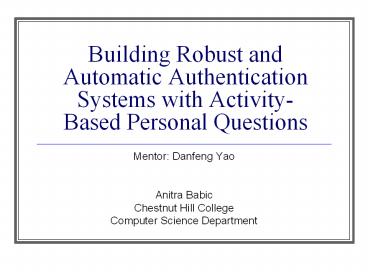Building Robust and Automatic Authentication Systems with Activity-Based Personal Questions - PowerPoint PPT Presentation
1 / 13
Title:
Building Robust and Automatic Authentication Systems with Activity-Based Personal Questions
Description:
... Analyzes browsing history and emails to generate questions ... server logs provide information T. Maybe an email/calendar server or an eCommerce server ... – PowerPoint PPT presentation
Number of Views:13
Avg rating:3.0/5.0
Title: Building Robust and Automatic Authentication Systems with Activity-Based Personal Questions
1
Building Robust and Automatic Authentication
Systems with Activity-Based Personal Questions
- Mentor Danfeng Yao
- Anitra Babic
- Chestnut Hill College
- Computer Science Department
2
Background
- A secret question is the question that will
often times be asked as a secondary
authentication question - Examples include
- What is your pers name?
- What is your favorite song?
- What was the name of your first school?
- This sort of security has appeared on
- Gmail, Yahoo! Mail, Hotmail, AOL, Facebook
3
Secret Questions Online
4
Negative Results of Secret Questions
- A Microsoft study found that currently
implemented secret questions are far from
foolproof - Focused on top four email providers secret
questions - 17 of a users friends could guess the answer on
first try - 13 could do it within 5 tries
- 13 are statically guessable
- The study focused on making secret questions
easier to remember for the user - Recognized Problems
- Not secure, difficult to remember
Schechter, S, Brush, A. J., Egelman, S
(2008). It's No Secret Measuring the security
and reliability of authentication via 'secret'
questions. 1-16.
5
Activity Based Authentication Requirements
- Question Requirements
- Secrecy dynamically change questions whenever
the challenge fails - Memorability recall the most their most recent
activity - Non-intrusiveness run in the background , no
user updating - Adaptability questions can be produced
automatically and dynamically each day
6
Activity Based Authentication Categories
- Network activity Focus on the size, type,
history, and content of user network activity. - Secrecy relative to popularity of sites visited
- Physical Events Information gathered from
emails, virtual calendars, ect. - Secrecy relative to how many people are attending
the event - Conceptual Opinions Analyzes browsing history
and emails to generate questions - Possibility they may be vulnerable to random
guessing attacks. - The k-out-of-n where users need to answer
correctly k questions out of provided n ones - For example, if there are three choices then the
probability of correctly guessing k questions is
(1/3)k assuming equal likelihood and uniform
distribution - attack success rate is low or a reasonably small
k, e.g., 1 for k 4 (assuming equal likelihood
7
Architectural Design of System
- Client-server architecture
- server utilizes the logged user transaction data
to extract questions and answers - Two phases, setup and authentication
- General model deployable on severs that provide
network related services - server logs provide information T
- Maybe an email/calendar server or an eCommerce
server
Image and Architecture designed by Huijun Xiong
8
Architecture of an Activity Based Authentication
System
Image and Architecture designed by Huijun Xiong
9
Preliminary Experiments and Results
- Survey of 12 questions, four from each activity
based question category - Participants were asked to answer then guess what
the others had answered - Had 4 participants, same mentor
- Temporal based questions most robust
- work-related questions were the most vulnerable
- opinion-based questions hard to attack
- All questions found to be memorable
10
Survey Results
11
Current and Future Work
- Currently planning a study to compare
conventional authentication questions with ours - Expanding our study to more diverse participants
- Plan to implement a prototype with the
integration of semantic web and natural language
processing techniques. - Start with an email server
- Plan to Explore the potential application of
host-based detection system against malicious
botnets.
12
Acknowledgements
- Danfeng Yao
- Huijun Xiong
- Alex Crowell
- Chih-Cheng Chang
13
Questions

